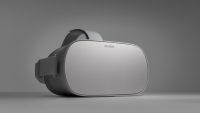CES: The Next Wave of Immersive Media Tech and Markets
December 10, 2018
For a long time, we have posited that the future of immersive media will be 10 percent virtual reality and 90 percent augmented reality. In the coming year the VR and AR technologies and markets will continue to advance, but in different directions and for different reasons. VR is moving into niche markets, location-based entertainment (LBE), business applications and eSports. Meanwhile, we expect AR to focus on innovation across numerous fronts, including high-end niche business and professional applications, low-end consumer experiences and new glasses with limited feature sets.
Since the widespread consumer adoption of VR that many analysts forecast a few years ago has not occurred, we are seeing many VR companies pivot into business applications. Businesses can afford the expense of high-end VR equipment and specialized applications, and they can determine an ROI for the experiences.
We also expect to see VR growth in eSports — not just in VR game play, but in immersive experiences for eSports immersive eStadiums where the Twitch crowd will be able to see multiple statistics and point-of-view screens while watching the players or they will be able to watch professional teams play from inside the game world.

As the prices for untethered, consumer VR headsets continue to decline, and as their features improve (inside-out tracking, spatial audio — for example: Oculus Go), we expect consumers to begin to view them as acceptably priced, limited-use devices that will deliver a specific experience or two, just like any specialized computer/game console peripheral device.
Most of the growth in mass market awareness will come from location-based entertainment in the next year. LBE gives consumers the chance to have an experience without the cost of buying and the hassle of setting up the equipment. The LBE global build-out is currently exploding for VR; with everything from VR installations within existing LBE sites (Dave & Buster’s), to arcades of off-the-shelf experiences (“mom-and-pop” operations), to unique and creative LBEs that incorporate social media, food services, and other elements (Two Bit Circus), to dedicated walk-around mixed reality experience spaces (The VOID, Spaces, Dreamscape, Zero Latency, VRcade).
Lessons learned in these installations will filter down to consumer VR products in the future. Those lessons may also help drive the technical standards and interoperability that will support mass market adoption.

We expect augmented reality to emphasize innovation in the next year. North-brand AR glasses, for example, have a very limited feature set, but are important because they demonstrate that AR glasses could look like normal glasses (pictured above). Expect to see more glasses like the North models to come out. They will have less than the full AR feature set of Hololens or Magic Leap, but they will meet enough consumer expectations and have enough fashion cache to be interesting to early adopters.
We also expect someone to market a soft wearable black-out hood for the glasses (for example: clip-on sunglasses meets airline sleep mask) that will turn them into VR glasses. Do not expect mass market prices for these fashionable AR glasses any time soon.
As with VR, AR is proving to be very useful and cost effective in high-end niche business and professional applications (remote expert advisor, medical surgery overlays) as well as low-end consumer experiences (phone-based AR measurement and placement of home décor — for example: the IKEA app).
User experience (UX) and user interface (UI) designers will explore new ways to be more intuitive and contextually consistent for all forms of immersive media. Beyond refining the handheld game controller, we expect advances in input and output technology and language related to all of the human senses — especially eye tracking, voice/sound, hand/body gestures, haptic feedback, and brain/computer interface.
The creative application tools and the object libraries for both VR and AR are becoming more drag-and-drop. As with media types that have come before (paint, printing press, video), this democratization of the medium’s tools means that as the technology gets out of the way of the creative process truly talented people will find new ways to make themselves and their work stand out.
We expect world-building environments to play an increasingly important role in adoption of both VR and AR. We have already seen meet-ups, live concerts, classes, eSports events, and other activities inside constructed worlds (High Fidelity).
As the technology underpinning immersive media improves (low latency, higher resolution, uncanny valley solutions), and the UX/UI becomes more natural, the technology will move into the background and the usefulness of this new media type will become apparent. Communities will migrate their social media, productivity tools, and other activities to immersive media as awareness grows.
Hanging over all of this are questions related to the ethics and social impact of this technology. Who owns the data that is collected in order to provide a personalized experience? What backchannel and user information should be collected? Should there be different guidelines if the data is processed within the consumer device versus uploaded to the cloud for processing? Do the scope of the click license and the definition of informed consent need to be re-examined? These issues will be the focus of much debate in the coming year, and will contribute to the direction of product development and business practices related to immersive media and other fields for the foreseeable future.
CES 2019 has a zone for AR/VR and Gaming (LVCC South Hall 1), hospitality suites for key players (ARIA Las Vegas), and sessions related to immersive media that we will be reporting on from the show in January.

No Comments Yet
You can be the first to comment!
Sorry, comments for this entry are closed at this time.